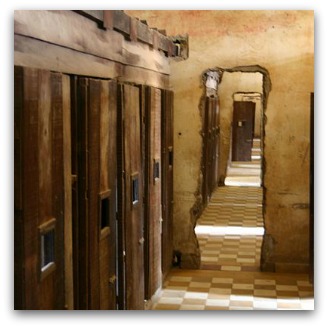http://www.eurekastreet.com.au
05 February, 2013
 Duch
slouches in his chair, his watery eyes keenly absorbing the next
question from the defence. He faces the chamber made up of three judges;
the joint prosecutorial team; civil parties; the defence team and
security guards. He thanks the presiding judge after each question.
Duch
slouches in his chair, his watery eyes keenly absorbing the next
question from the defence. He faces the chamber made up of three judges;
the joint prosecutorial team; civil parties; the defence team and
security guards. He thanks the presiding judge after each question.We are at the Extraordinary Chambers of the Cambodian Court (ECCC) in Phnom Penh, Cambodia. A hybrid United Nations-Cambodia court established in 2003 with a mandate to try serious crimes committed during the Khmer Rouge regime. This is just the second case brought to trial.
You wouldn't find Tuol Sleng (or S21) if you didn't know where to look. The genocide museum is embedded in the inner suburbs of Phnom Penh, an innocuous, decrepit school building. We saw photos of Duch as we wandered numb with horror through the archives of Khmer suspects who were interrogated and tortured at S21, then driven to Cheoung Ek on the outskirts of Phnom Penh and slaughtered.
It is not Duch's trial. Sentenced for life in an earlier trial, and on appeal, he is appearing as a witness in this trial of three former leaders of the Khmer Rouge regime that ruled Cambodia between 1975–1979: Nuon Chea, aged 84; Khieu Samphan, aged 79; and Ieng Sary, aged 85. Behind the row of defence lawyers three bald, bowed heads are just visible from the public gallery.
The photos of Duch at S21 are from the period; in one he stands tall among a small group of staff in the early days of the prison. In another, he sits at his desk, pen raised, white teeth flashing in the grey scale image.
In the courtroom, Duch continues to carefully respond to the questions of the American defence lawyer for Nuon Chea. It is his seventh day on the witness stand, having spent the previous six days being examined by the prosecution. The proceedings ramble along, stumbling over procedure and the challenges of a complex case of allegations of war crimes and genocide committed over three decades ago, in Khmer, French and English.
A school before 1975, S21 became the central interrogation and torture point for enemies suspected of undermining the revolution. The genocide museum documents the extensive use of torture to solicit confessions from prisoners. As head of S21, Duch was responsible for ensuring that these confessions, at times running to hundreds of pages, satisfied the requirements of his political masters.
A teacher before the revolution, Duch made annotations in red pen on confessions asking interrogators to elicit information or detail from prisoners, usually through torture.
Slowly the defence draws out an important point — Duch today cannot accurately state the sum of his knowledge of the apparatus of the Khmer Rouge regime during its reign. His understanding in the intervening decades has been developed through extensive reading about the state he served.
We survey the classrooms and open corridors at S21, maintained in the state in which it was found in 1979. At first glance, the only striking aspect of S21 is the razor wire descending on the outside of the corridors — placed there to stop prisoners attempting suicide.
The classrooms are bare save for two remnants: an iron bed with metal manacles still attached, and a grainy image of the last prisoner found in each room. The photos, taken by the Vietnamese upon arrival, show grotesque corpses left rotting by Duch and his staff days before. The bodies of these prisoners were still bloody and mangled, smashed in anguished positions at death.
At S21, hundreds of terrified Khmers are frozen in black and white film, their images at the point of capture displayed to the world. Though not comparable in scale, they resonate with the jumbled thousands of spectacles, suitcases and assorted shoes catalogued and stored at Auschwitz. Men, women and children look back through time from hell on earth.
At the ECCC, Arendt's Eichmann comes to mind. Duch appears caught between his own arguments. On the one hand, his reasons are exculpatory: he was a middling bureaucrat of limited influence trapped by fear. At his own trial, Duch said he was 'both a hostage and an actor in a criminal regime'.
On the other hand, his language is embedded with the revolutionary zeal of committed Khmer Rouge. Writer David Chandler describes Duch as an enthusiastic and proud administrator.
At the lunch adjournment, Nuon Chea's lawyer rises and requests the court allow his client to observe proceedings from the holding cell for the rest of the day. The presiding judge agrees. The three bald men rise slowly as the judges depart and head waveringly for the cells.
Critics of the ECCC question the point of dragging out the horrors of the past from elderly Khmer Rouge revolutionaries. S21 serves as a reminder of the need for restorative justice and the telling of the Khmer Rouge story. Duch is an important figure, as both a middle man and genocidaire, key to understanding and preventing future atrocities in Cambodia and across the world.
Case 002 of the Extraordinary Chambers of the Cambodian Court (ECCC) continues.
 Nik
Tan is a lawyer and former DFAT officer who has lived and worked in
both Indonesia and Timor Leste as a teacher, interpreter and UN election
observer. He was overseeing coordinator of the Sudanese Australian
Integrated Learning (SAIL) Program between 2008 and 2012.
Nik
Tan is a lawyer and former DFAT officer who has lived and worked in
both Indonesia and Timor Leste as a teacher, interpreter and UN election
observer. He was overseeing coordinator of the Sudanese Australian
Integrated Learning (SAIL) Program between 2008 and 2012. 
No comments:
Post a Comment